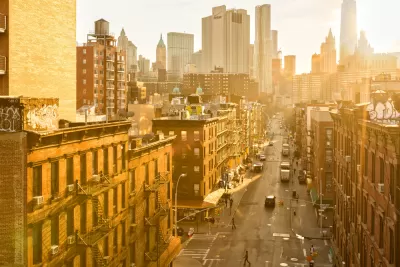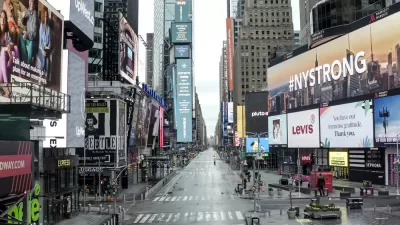Building more housing where people work is a simple way to come out of the pandemic with a stronger sense of community and shorter commutes, according to this article.

Pandemic lockdown has changed the way people relate to the cities in which they live, shop, and work. Increasingly, say Michael Hendrix and John Ketcham, the coronavirus pandemic has changed the way residents of the New York City region commute and shed light on the fact that under 'normal' circumstances, hordes of people commute into cities on a daily basis to get to work.
Hedrix and Ketcham opine that instead of allowing the commute to continue, planners and lawmakers should increase housing supply in commercial areas. Upzoning commercial areas, they say, will minimize commute times while improving neighborhood quality and individuals' quality of life.
The article urges for the transformation of New York City neighborhoods, its authors arguing that density controls and regulation opposing adaptive reuse are ultimately damaging to community vitality in the Big Apple. Not enough housing has been built in areas where jobs are growing. "An October 2019 report by the New York City Department of City Planning found that from 2009 to 2018, 700,000 new jobs were added in the city, compared with only 197,000 new housing units permitted," write Hedrix and Ketcham.
Given the decreasing demand for urban retail and office space, planners and politicians should begin to build housing in those areas where demand will ultimately crop up again. According to Hedrix and Ketcham. "With the right policies, this time of crisis can give way to more neighborhoods where we live, work, and play."
FULL STORY: More housing is the answer to less transit

Study: Maui’s Plan to Convert Vacation Rentals to Long-Term Housing Could Cause Nearly $1 Billion Economic Loss
The plan would reduce visitor accommodation by 25,% resulting in 1,900 jobs lost.

North Texas Transit Leaders Tout Benefits of TOD for Growing Region
At a summit focused on transit-oriented development, policymakers discussed how North Texas’ expanded light rail system can serve as a tool for economic growth.

Why Should We Subsidize Public Transportation?
Many public transit agencies face financial stress due to rising costs, declining fare revenue, and declining subsidies. Transit advocates must provide a strong business case for increasing public transit funding.

How to Make US Trains Faster
Changes to boarding platforms and a switch to electric trains could improve U.S. passenger rail service without the added cost of high-speed rail.

Columbia’s Revitalized ‘Loop’ Is a Hub for Local Entrepreneurs
A focus on small businesses is helping a commercial corridor in Columbia, Missouri thrive.

Invasive Insect Threatens Minnesota’s Ash Forests
The Emerald Ash Borer is a rapidly spreading invasive pest threatening Minnesota’s ash trees, and homeowners are encouraged to plant diverse replacement species, avoid moving ash firewood, and monitor for signs of infestation.
Urban Design for Planners 1: Software Tools
This six-course series explores essential urban design concepts using open source software and equips planners with the tools they need to participate fully in the urban design process.
Planning for Universal Design
Learn the tools for implementing Universal Design in planning regulations.
Ascent Environmental
Borough of Carlisle
Institute for Housing and Urban Development Studies (IHS)
City of Grandview
Harvard GSD Executive Education
Toledo-Lucas County Plan Commissions
Salt Lake City
NYU Wagner Graduate School of Public Service





























